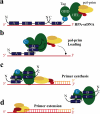A dynamic model for replication protein A (RPA) function in DNA processing pathways
- PMID: 16935876
- PMCID: PMC1616954
- DOI: 10.1093/nar/gkl550
A dynamic model for replication protein A (RPA) function in DNA processing pathways
Abstract
Processing of DNA in replication, repair and recombination pathways in cells of all organisms requires the participation of at least one major single-stranded DNA (ssDNA)-binding protein. This protein protects ssDNA from nucleolytic damage, prevents hairpin formation and blocks DNA reannealing until the processing pathway is successfully completed. Many ssDNA-binding proteins interact physically and functionally with a variety of other DNA processing proteins. These interactions are thought to temporally order and guide the parade of proteins that 'trade places' on the ssDNA, a model known as 'hand-off', as the processing pathway progresses. How this hand-off mechanism works remains poorly understood. Recent studies of the conserved eukaryotic ssDNA-binding protein replication protein A (RPA) suggest a novel mechanism by which proteins may trade places on ssDNA by binding to RPA and mediating conformation changes that alter the ssDNA-binding properties of RPA. This article reviews the structure and function of RPA, summarizes recent studies of RPA in DNA replication and other DNA processing pathways, and proposes a general model for the role of RPA in protein-mediated hand-off.
Figures




Similar articles
-
[Replication protein A as a major eukaryotic single-stranded DNA-binding protein and its role in DNA repair].Mol Biol (Mosk). 2016 Sep-Oct;50(5):735-750. doi: 10.7868/S0026898416030083. Mol Biol (Mosk). 2016. PMID: 27830676 Review. Russian.
-
DNA annealing by RAD52 protein is stimulated by specific interaction with the complex of replication protein A and single-stranded DNA.Proc Natl Acad Sci U S A. 1998 May 26;95(11):6049-54. doi: 10.1073/pnas.95.11.6049. Proc Natl Acad Sci U S A. 1998. PMID: 9600915 Free PMC article.
-
Dynamic regulatory interactions of rad51, rad52, and replication protein-a in recombination intermediates.J Mol Biol. 2009 Jul 3;390(1):45-55. doi: 10.1016/j.jmb.2009.05.009. Epub 2009 May 13. J Mol Biol. 2009. PMID: 19445949
-
Generation of Fluorescent Versions of Saccharomyces cerevisiae RPA to Study the Conformational Dynamics of Its ssDNA-Binding Domains.Methods Mol Biol. 2021;2281:151-168. doi: 10.1007/978-1-0716-1290-3_9. Methods Mol Biol. 2021. PMID: 33847957 Free PMC article.
-
Replication protein A: single-stranded DNA's first responder: dynamic DNA-interactions allow replication protein A to direct single-strand DNA intermediates into different pathways for synthesis or repair.Bioessays. 2014 Dec;36(12):1156-61. doi: 10.1002/bies.201400107. Epub 2014 Aug 29. Bioessays. 2014. PMID: 25171654 Free PMC article. Review.
Cited by
-
The N-terminus of RPA large subunit and its spatial position are important for the 5'->3' resection of DNA double-strand breaks.Nucleic Acids Res. 2015 Oct 15;43(18):8790-800. doi: 10.1093/nar/gkv764. Epub 2015 Jul 30. Nucleic Acids Res. 2015. PMID: 26227969 Free PMC article.
-
Replication protein A: directing traffic at the intersection of replication and repair.Front Biosci (Landmark Ed). 2010 Jun 1;15(3):883-900. doi: 10.2741/3652. Front Biosci (Landmark Ed). 2010. PMID: 20515732 Free PMC article. Review.
-
Replication Protein A Enhances Kinetics of Uracil DNA Glycosylase on ssDNA and Across DNA Junctions: Explored with a DNA Repair Complex Produced with SpyCatcher/SpyTag Ligation.Chembiochem. 2023 May 16;24(10):e202200765. doi: 10.1002/cbic.202200765. Epub 2023 Apr 18. Chembiochem. 2023. PMID: 36883884 Free PMC article.
-
RAD6-RAD18-RAD5-pathway-dependent tolerance to chronic low-dose ultraviolet light.Nature. 2009 Jan 29;457(7229):612-5. doi: 10.1038/nature07580. Epub 2008 Dec 14. Nature. 2009. PMID: 19079240
-
Recombinant adeno-associated viral vectors are deficient in provoking a DNA damage response.J Virol. 2008 Aug;82(15):7379-87. doi: 10.1128/JVI.00358-08. Epub 2008 May 7. J Virol. 2008. PMID: 18463154 Free PMC article.
References
-
- Fanning E., Knippers R. Structure and function of simian virus 40 large tumor antigen. Ann. Rev. Biochem. 1992;61:55–85. - PubMed
-
- Bullock P.A. The initiation of simian virus 40 DNA replication in vitro. Crit. Rev. Biochem. Mol. Biol. 1997;32:503–568. - PubMed
-
- Waga S., Stillman B. The DNA replication fork in eukaryotic cells. Ann. Rev. Biochem. 1998;67:721–751. - PubMed
-
- Simmons D.T. SV40 large T antigen functions in DNA replication and transformation. Adv. Virus Res. 2000;55:75–134. - PubMed
-
- Stenlund A. Initiation of DNA replication: lessons from viral initiator proteins. Nature Rev. Mol. Cell Biol. 2003;4:777–785. - PubMed
Publication types
MeSH terms
Substances
Grants and funding
LinkOut - more resources
Full Text Sources
Other Literature Sources
Molecular Biology Databases

